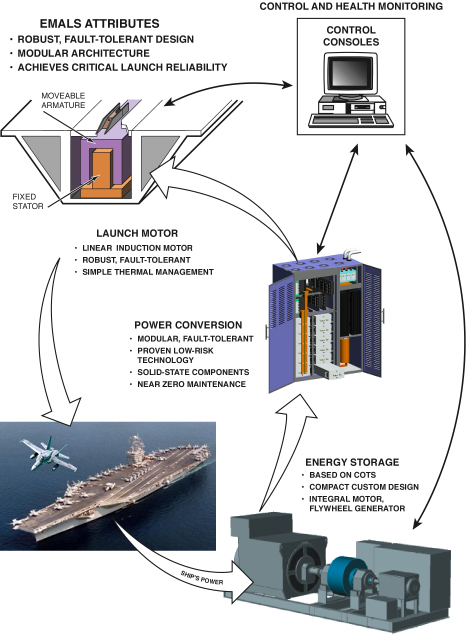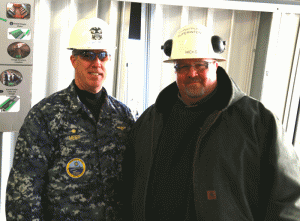2015-01-26 CVN 78 is being built to support a half century of air-breathing platform innovations.
The new carrier will see the UCAS, the new Hawkeye, the Osprey and the F-35C come onboard.
This is the beginning of the decade ahead of innovation.
But what comes next?
The new catapult and landing gear systems are designed to allow for innovation for lighter or heavier air-breathing systems, manned or remotely piloted, for the years ahead.
The shift from steam and hydraulics to electro-magnetic pulse and the implementation of an advanced arresting gear is designed to enable a long-term transformation of the embarked air wing.
During our visit to the Gerald R. Ford, we examined both the Electro-Magnetic Aircraft Launch System (EMALS) and the Advanced Arresting Gear (AAG) and discussed them with Captain Meier and with Mr. Hicks, Construction Superintendent.
EMALS
According to Hicks, there are three, highly publicized, new technologies aboard the ship: EMALS, AAG and the dual band radar. There are many other improvements but these are foundational systems for the new carrier along with the new weapons handling system.
The two big steam cylinders are replaced with banks of electromagnetic motors.
A great advantage of EMALS is the acceleration curve is very smooth.
It ramps up very smooth as opposed to a steam cat that spikes up on the front end.
The control that you have around that acceleration is virtually infinite.
And if you get half way down the cat and the system senses that you’re not getting there, it will increase power as necessary to reach end speed.
The system itself is intelligent enough to increase power as you go and increase the acceleration rate so that at the end you’re actually going 160 knots per hour or whatever you want to be at the end.

Question: Computer control must play a key role in the system?
Hicks: It does. With the steam catapult, the steam valve opens and you get what you get.
If it turns out the speed is not building up as expected, you have no other options. The system is not going to try to fix itself.
This system has tons of detectors in it that every little nuance and every step along the way is measured , it knows what the speed should be, what the speed is, what power is available and how to increase power or decrease power as necessary.
When you think about that there’s a whole array of failures that can happen within this system and still give the proper launch speed.
It’s impressive to watch the system operate at Lakehurst.
They deliver 150 knots every single time.
Question: This will allow for less loss of aircraft and provide less wear and tear on the airframes?
Hicks: It should reduce the wear and tear on the airframes.
Question: We are looking at the EMALS on the deck, what remains to be done prior to testing onboard the ship?
Hicks: We actually started cat trough alignment around this time last year and have completely aligned all 4 catapults now.
All of the motor sections and electrical cabling in cats 1 and 2 are complete.
We have everything installed in this track (Catapult 2) with the exception of the covers. At this point we’re setting up for testing within the next few weeks. We’re ready to send power to the trough at this point.
Below decks we are 5 months into our test program, and are testing the generators. We are right on our original schedule.
Question: Maintenance should be improved as you shift from hydraulics and steam?
Hicks: It clearly should and we provide a very different approach to maintenance as well associated with computer management of an electric power driven system.
There is a single officer on a single console who does the health monitoring of the system and will guide the maintenance process.
This system is one of numerous initiatives built into the design of this ship that will allow us to change from the current nine to ten year dry dock repair cycle and extend it to a 12 year docking cycle.
Essentially in a half-life you have taken away one full dry dock repair cycle.
AAG
When we visited the AAG work area, Hicks provided us with an explanation of what we were seeing in the workspace.
Essentially what used to be in this space would’ve been a large hydraulic ram.
The hydraulic ram would’ve had cables attached to it and the cables would’ve come out up across the flight deck and as the aircraft makes a trap, the hydraulic ram would push fluid through a cascading orifice that was set based on the specific aircraft arrested.
That’s all been replaced with a new advanced arresting gear.

“Advanced arresting gear is actually three main components starting with an electric motor, a cable drum and a water twister.
The real technological breakthrough here is this water twister.
The water twister is essentially a dead headed pump, a paddle wheel for lack of a better term. That’s the brawn of the system.
It’ll take up most of the energy.
It’ll actually pull in probably 70% or so of the energy.The cable drum itself but nothing more than a fishing reel. It just winds up the cable.
And the electric motor is essentially the brains of the system.
So if you were to catch a very light aircraft the water twister would want to rip the tail hook off. The electric motor, when light aircraft come in, will adjust the system to the appropriate measures to land the aircraft.
It’ll actually make the deceleration curve very similar to EMALs acceleration curve, and it’ll make that very smooth as well as opposed to a hydraulic ram.”
Question: Where are you with regard to installing the AAG on the Ford?
Hicks: From an install perspective, on the ship today we have all the cable drums and the motors installed and have three of the six water twisters now installed, and these mechanics are actually installing the sheer blocks around this critically aligned machinery.
For earlier pieces on CVN 78 based on our visit to the ship see the following:
https://sldinfo.com/the-arrival-of-the-cvn-78-the-ships-captain-talks-about-the-way-ahead/
https://sldinfo.com/crafting-the-gerald-r-ford-flight-deck-enlarging-the-operational-space/
https://sldinfo.com/shaping-flexible-c2-at-sea-the-role-of-flexible-infrastructure/
https://sldinfo.com/the-second-line-of-defense-visit-to-the-uss-gerald-ford/

